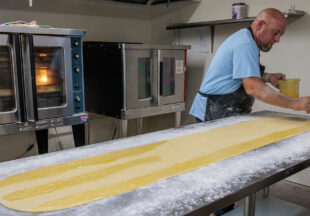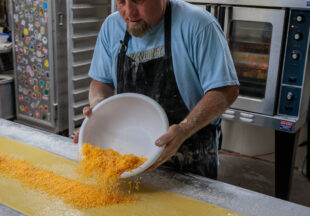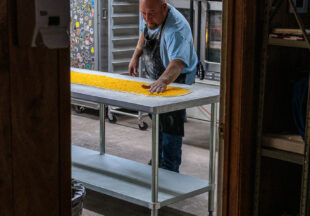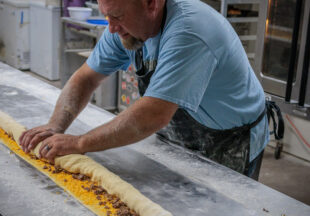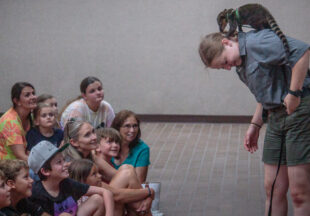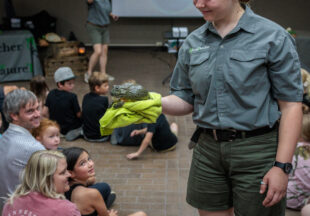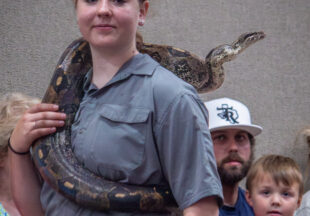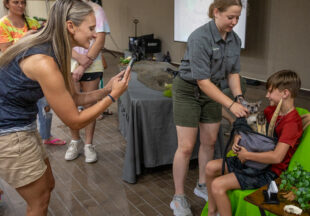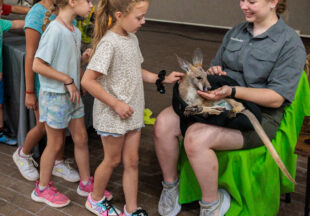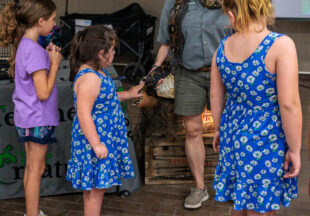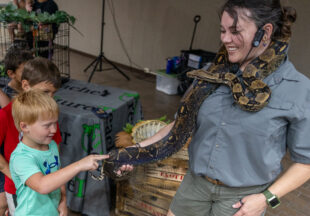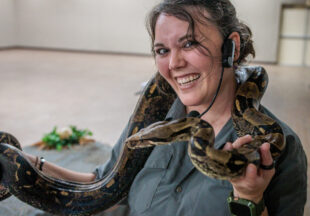High-tech training gives Sheriff’s Office real-world driving challenges

Stephens County Jail Administrator Maj. James Barrera gripped the steering wheel, his car’s siren screaming and red lights flashing as he sped down a curved highway in hot pursuit of a car in front of him. He was chasing a Honda Civic driven by a suspect wanted for armed robbery where shots were fired, so he knew the driver was armed and dangerous.
The chase started in the city when the suspect’s car drove past him at an intersection. Barerra turned on his siren and red lights and the suspect’s car took off, so he engaged the suspect in a pursuit.
Eventually the chase made its way onto the open highways in the countryside. Barrera’s car engine roared as he accelerated and the car slid around on the highway, at times sliding completely off of the roadway. Throughout the pursuit, he not only had to stay focused on the car he was chasing, but he also had to be aware everything else going on around him. There was other traffic to watch out for, pedestrians stepping into the street and other road hazards along the way.
This was Barrera’s first high-speed pursuit and it wasn’t real – but it sure felt like it, he said.
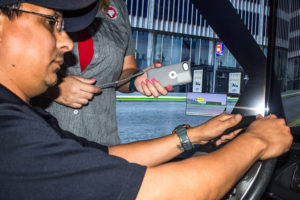
Maj. James Barrera trains on the driving simulator at the Stephens County Law Enforcement Center this week. (Photo by Tony Pilkington/Breckenridge Texan)
Barrera was driving a patrol car simulator as part of the driver training that was being provided to the Stephens County Sheriff’s Office employees by Texas Association of Counties. TAC’s driving simulator creates real-world driving conditions in a high-tech environment that replicates situations drivers may actually encounter while on the road.
Since its launch in 2000, more than 8,400 county drivers in 75 percent of the state’s counties have used it to enhance their ability to make life-saving, split-second decisions in often dangerous driving conditions.
Stephens County Sheriff Will Holt said all of the deputies and transport officers, including the sheriff himself, went through the classroom and simulation training this week. He said four members of the jail staff are transport officers who drive to and from other jails and jurisdictions to taking or picking up inmates.
Barrera said the training was the first time he’s ever had any experience with driving in pursuit and it was a completely different experience than he expected.
“Well, you’ve got the siren going, and you’re looking every which way. Your heart’s racing, so even though it’s a simulation, that siren and those lights… it kinda gets your blood going. You’re, like, looking everywhere; you’re holding on to that steering wheel, so yeah, it’s very different.”
He said that during the pursuit there was more going on around him than he expected and he had to look at everything, including cross traffic and other people’s driving. He said you can’t just focus on the vehicle that you’re chasing; you have to look 360 degrees everywhere you’re going.
“It’s fun. It’s very exciting, but at the same time, even though you know it’s not real, you’re nervous you’re going to make the wrong move, so you’re kind of hesitant to do what your instincts are telling you to do, so you’re kinda second guessing yourself,” Barrera said.
For Malcolm Bufkin Jr., a detention officer at the jail who is also a transport driver, there were a lot of surprises during the pursuit portion of the training. “I’ve never done anything like that, real or simulated,” he said. “There were definitely surprises, like some of the traffic not being aware. I was in the middle of the intersection, and that vehicle that hit me from the left side just plowed right into me.”
He said driving during the pursuit simulation was pretty chaotic because there were lot things to look out for all at once and still maintain the pursuit.
Deputy Bill Flournoy has driven in actual high-speed emergency situations on the job and also went through the simulator training this week, and he said the simulator was very close to the actual experience in the real world. He said it was real enough that it gets the tension going, like a real situation.
“It did,” he said. “Knowing that I had people behind me, with the lights and the siren; pretty much when the lights and siren go on, it’s not that you get excited, but your adrenaline jumps and you just start getting ‘OK, OK.’ Then you realize people are shooting at you. It’s pretty close.”
He said one of the things the training focused on was avoiding tunnel vision and paying attention to everything that’s going around you during the pursuit.
“They were pressing us to pay more attention peripherally,” he said about the training. “You’ve got citizens out there that are tunnel vision, too, and they may not see you. They may not even know you’re there until you go flying in front of them. The scenario I went through, I was chasing a vehicle that was shooting at me, and I didn’t even see the Frito Lay truck that didn’t stop. And he drove right into me. People will step out in front of you and everything else.”
During the classroom portion of the training, he said, one thing the instructor talked about, which he said he already does and most officers already do, is not just blowing through an intersection. He said they almost completely come to a stop at an intersection, even in a high-speed pursuit.
“Like she said, if I‘m chasing somebody or I’m on my way to an assault or anything else, if I get in an accident, it’s going to be that much longer before an officer gets to where he needs to go or the guy is going to completely get away,” he said.
Carmen S. Napp, the driving simulator consultant, is a retired Moore County chief deputy with 26 years of law enforcement experience. She taught both the classroom and simulator training at the Stephens County Law Enforcement Center.
The simulator was provided by TAC and was inside a trailer that was set up behind the LEC. Inside the trailer, there is a driver’s seat, complete with seatbelt, steering wheel and brake and gas pedals. There are three large video screens — one in front of the driver and one on each side of the driver — that create a complete scene around the driver. That way, the driver sees what’s going on in front of him or her and on the sides, just like in a real driving situation. There is also a simulated rear-view mirror that shows what’s going on behind the driver.
Napp said the drivers go through three scenarios in the simulator. She said the first one is an acclimation scenario where they get used to having screens on the side and not just watching the front screen.
The second scenario is driving with no brakes or inoperable brakes and having to maneuver the vehicle through a series of obstacles without brakes by controlling their speed. She said that is the most difficult course and the one they have the most crashes on.
She said the third scenario is the pursuit. Napp said that in one of the pursuits, they go through a residential apartment complex, then a ball will roll out in front of them and suddenly a little kid shows up. She said there is also a motorcycle in one, and they think motorcycle is going to stop but it doesn’t.
“I try to tell them that on a pursuit, there are times to call it off, and, of course, the supervisor will call it off. Just remember, there’s always another day or a radio, and you can call ahead. They’re not getting too far away,” she said.
Napp said that in addition to the high-speed training, the instruction also includes defensive driving and safe driving tactics like checking intersections and backing up safely, the kind of things people tend to forget the longer they drive.
After the officers receive the training, she said, they seem to be more cautious when they go out on patrol, checking intersections a little more and taking the time to remember the steps they were taught in the classroom and driving simulator.
Napp said some other scenarios that TAC wants to implement in future training are a u-turn scenario and a back up scenario.
“We’re finding that officers when they’re going to make a traffic stop, they’ll make a u-turn on a violator and be hit from the side or behind,” she said.
With backups, an officer will get a hot call while they are eating dinner or they’re at the office doing reports and they jump in their car, throw it in reverse and they don’t look behind them and they hit somebody, Napp said.
The training is a free service that’s offered to counties that are members of TAC, which includes Stephens County.
Holt said the training is very helpful. He said, generally speaking, year in and year out, the top three circumstance in which law enforcement officers die in the line of duty are domestic disturbances, car accidents and traffic stops. He said this type of training addresses directly and indirectly two of the top three circumstances when officers are killed in the line of duty.
“You can never have a enough training and emergency driving and also defensive driving,” he said. “So, we’re grateful for the Texas Association of Counties to offer this. They had an opening, and we were happy to host them.”
Holt, who said he has been involved in high-speed pursuits in his past law enforcement experiences, said training like this is important in law enforcement because they have to train to know how they’re going to respond mentally and physically in such situations and it also teaches them how to handle those situations.
“Hopefully, we’re learning where our weaknesses and constraints are, so that when we get into those situations in the real world, we can prevent injuries to others, injury to ourselves and damage to county property,” he said.
Story by Tony Pilkington/Breckenridge Texan
Cutline, top photo: Stephens County Deputy Bill Flournoy drives a simulator during training at the Stephens County Law Enforcement Center on Wednesday, Aug. 1. The classroom and simulator training was provided to the Stephens County Sheriff’s Office by the Texas Association of Counties. (Photo by Tony Pilkington/Breckenridge Texan)
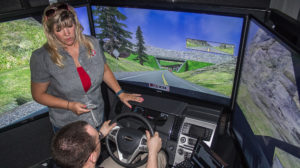
Carmen S. Napp, a driving simulator consultant with the Texas Association of Counties, gives instructions to Stephens County Detention Officer Malcolm Bufkin Jr. during driving training on Wednesday, Aug. 1, at the Stephens County Law Enforcement Center. (Photo by Tony Pilkington/Breckenridge Texan)











